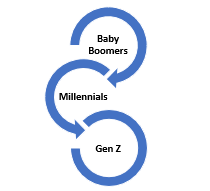Navigating the Multigenerational Workplace
Meeting Diverse Needs from Baby Boomers to Gen Z
In today’s dynamic work environment, it’s not uncommon to find Baby Boomers, Generation X, Millennials, and Gen Z working side by side. This unprecedented generational mix brings together a rich tapestry of experiences, perspectives, and expectations. For HR professionals, understanding and addressing the unique needs of each generation has become crucial. These needs are often so significant that employees are willing to leave a job if they aren’t met. Let’s delve into how HR can effectively navigate this multigenerational landscape and foster a workplace where every generation can thrive

Understanding the Generational Spectrum
1. Baby Boomers (Born 1946-1964): Baby Boomers are individuals born between 1946 and 1964. This generation was named for the significant increase in birth rates that followed World War II, often referred to as the “baby boom.”
- Values: Stability, loyalty, and hard work. They often value structured hierarchies and clear career progression.
- Needs: Competitive salaries, strong benefits, and recognition for their experience and long-term commitment.
2. Generation X (Born 1965-1980): Generation X is often characterized as a smaller cohort compared to the Baby Boomers and Millennials. This generation is sometimes called the “middle child” of generations, positioned between the large Baby Boomer and Millennial groups.
- Values: Independence, self-reliance, and work-life balance. They appreciate a pragmatic approach and value results over processes.
- Needs: Flexible work arrangements, opportunities for professional development, and recognition of their efforts.
3. Millennials (Born 1981-1996): Millennials, also known as Generation Y, are individuals born between 1981 and 1996. This generation is notable for its distinctive characteristics shaped by the rapid technological advancements and significant social changes that occurred during their formative years.
- Values: Collaboration, meaningful work, and rapid advancement. They pursue significance and consistency with their ideas.
- Needs: Career growth opportunities, a positive work culture, and a strong sense of purpose in their roles.
4. Generation Z (Born 1997-2012): Generation Z, often referred to as Gen Z, includes individuals born from 1997 to 2012. This generation follows Millennials and is distinguished by its unique relationship with technology and its experiences growing up in a rapidly changing world.
- Values: Digital fluency, inclusivity, and work-life integration. They are driven by technology and social responsibility.
- Needs: Modern technology, flexible work options, and a workplace that reflects their values on social issues and diversity.
Bridging the Generational Gap: HR Strategies for Success
1. Craft Personalized Benefits and Compensation Packages
Different generations value different aspects of compensation and benefits. HR should consider:
- Customized Benefits: Offer a range of benefits options to cater to varying needs, such as enhanced retirement plans for Baby Boomers and student loan repayment assistance for Millennials and Gen Z.
- Flexible Compensation: Allow employees to choose benefits that align with their personal needs, whether it’s additional vacation days, wellness programs, or educational reimbursements.
2. Promote Career Development and Growth
Career advancement is a key motivator across all generations, but the approach to development varies:
- Structured Career Paths: For Baby Boomers and Gen X, provide clear career trajectories and advancement opportunities.
- Learning and Development: Millennials and Gen Z crave continuous learning. Implement robust training programs and mentorship opportunities that cater to different learning styles.
3. Foster an Inclusive and Collaborative Culture
Creating a workplace culture that values diversity and inclusion is essential:
- Intergenerational Collaboration: Facilitate projects and initiatives that encourage cross-generational teamwork. This can lead to innovative solutions and mutual understanding.
- Inclusive Policies: Develop policies that address the diverse needs of employees, such as flexible work arrangements, inclusive communication practices, and support for various personal circumstances.
4. Leverage Technology for Enhanced Engagement
Technology plays a crucial role in meeting the needs of different generations:
- Modern Tools: Invest in up-to-date technology that enhances productivity and communication. Ensure that tools are user-friendly for all employees.
- Digital Communication: Utilize platforms that facilitate collaboration and feedback across generations, such as project management tools and virtual meeting software.
5. Encourage Feedback and Open Communication
Regular feedback helps address issues before they become significant concerns:
- Feedback Channels: Create multiple channels for feedback to accommodate different communication preferences, from formal performance reviews to informal check-ins.
- Active Listening: Ensure that feedback is acted upon and that employees feel heard and valued. This approach helps in retaining talent and improving workplace satisfaction.
6. Design Workspaces that Reflect Diverse Needs
The physical workspace can impact employee satisfaction and productivity:
- Flexible Workspaces: Offer a variety of workspaces, from quiet zones for focused work to collaborative areas for team projects.
- Remote Work Options: Consider hybrid or remote work options that cater to the preferences of younger generations while maintaining a structured environment for those who value a traditional office setting.
Conclusion
The multigenerational workforce presents both opportunities and challenges. HR professionals must be adept at understanding and addressing the diverse needs of employees from Baby Boomers to Gen Z. By crafting personalized benefits, promoting career development, fostering an inclusive culture, leveraging technology, encouraging feedback, and designing flexible workspaces, HR can create a harmonious work environment where every generation feels valued and engaged. Meeting these needs effectively not only enhances employee satisfaction but also reduces turnover, making your organization a desirable place to work for individuals across all age groups.
By – Kirti Kumari